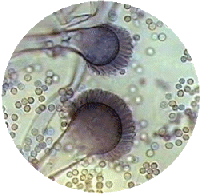You are Burying Your Face in a Hot Zone for Fungal Spores Every Night: Your Pillow
by www.SixWise.com
If you are the type of person who checks your ceiling for
spiders before falling asleep, or you cringe at the thought
of a bug coming anywhere near your body, you may want to brace
yourself. There is a "miniature ecosystem" -- complete
with dust-mite-eating fungi - -living and thriving in the
place you'd least expect it: your pillow.
And it doesn't matter if you just bought your pillow or have
had it for 20 years. In a new study published in the journal
Allergy, researchers at the University of Manchester
sampled 10 pillows that were between 1.5 and 20 years old.
ALL of the pillows had fungal spores -- more than 1
million per pillow!
|

Researchers identified several thousand spores of fungus
per gram of pillow in their study.
|
Each sample contained four to 16 different species, and the
one that was the most common, Aspergillus fumigatus, is also
the one that's most likely to cause disease. Bread and vine
molds
and fungus usually found in damp showers and walls were also
found.
"We know that pillows are inhabited by the house dust
mite, which eats fungi, and one theory is that the fungi are
in turn using the house dust mites' feces as a major source
of nitrogen and nutrition (along with human skin scales).
There could therefore be a 'miniature ecosystem' at work inside
our pillows," said Professor Ashley Woodcock who led
the study.
How Fungus in Your Pillow Could Make You Sick
The idea of laying your face on a fungus-loaded pillow is,
well, disgusting. But even worse than that is the idea that
this fungus can actually make you sick -- and it can.
Aspergillosis is the name of the infection, growth or allergic
reaction caused by Aspergillus fumigatus (again, the type
most likely to be in your pillow and also found growing on
dead leaves, stored grain, ground pepper, house
plants, compost piles and other decaying vegetation).
It can cause illness in three ways:
-
As an allergic reaction; people with asthma are most
at risk.
-
As a growth in a healed lung cavity from a previous
disease like tuberculosis or lung abscess. This results
in a fungus ball being formed and potential bleeding in
the lungs.
-
As an invasive infection with pneumonia. This can cause
blindness and spread to any organ in the body, particularly
the heart, lungs, brain and kidneys. People with suppressed
immune systems, such as those with cancer, AIDS, leukemia,
organ transplants or chemotherapy, are almost exclusively
the ones at risk.
In fact, Aspergillosis is the leading infectious cause of
death in people with leukemia and bone marrow transplant patients.
It is also becoming increasingly common among other patient
groups and is difficult to treat. As a result, up to one out
of every 25 patients who die in modern teaching hospitals
in Europe have the disease.
Fungus Linked to Chronic Sinusitis
Nearly 17 percent of U.S. adults suffer from chronic sinusitis.
Last year, researchers found, for the first time, that the
condition appears to be an immune disorder caused by fungus.
The researchers suggested that when fungi lodge into the
mucus lining of the sinuses, people prone to sinusitis have
an immune response, which causes the fungus to be attacked.
Although this seems like it would be a positive move, it actually
leads to damage of the sinus membranes and full-blown sinusitis
symptoms like thick mucus and loss of the sense of smell.
|

This is Aspergillus fumigatus, the most common type
of fungus found in pillows.
|
"We showed in 1999 that fungal organisms were present
in the mucus of 96 percent of patients who had surgery for
chronic sinusitis, and that inflammatory cells were clumped
around the fungi, which indicated to us that the condition
was an immune disorder caused by fungus. But many doctors
didn't believe us," said researcher David A. Sherris,
M.D., interim chair of the University at Buffalo Department
of Otolaryngology.
Lower Respiratory Infection and Fungus
A study published in the July 2003 issue of the American
Journal of Respiratory and Critical Care Medicine found a
link between fungi in homes and lower respiratory infections
in infants. Out of 492 homes surveyed, 324 had high levels
of at least one type of fungi. Infants who lived in homes
with more than the 90th percentile for one or more types of
fungi had an 86 percent increased risk of developing a lower
respiratory illness by their first birthday.
However, fungi affect everyone differently, so not everyone
who's exposed will have a problem. "People are routinely
exposed to more than 200 different species of fungi. Exposure
occurs universally and is impossible to avoid completely.
Often, there are no adverse effects, but, at times, exposure
to fungi can directly and in-directly influence an individual's
health," said Diane R. Gold, M.D., M.P.H., of Harvard
Medical School.
Fungus may Worsen Asthma
The Aspergillus fungus can exacerbate asthma in adults and
cause allergic sinusitis in people with allergic tendencies.
Since exposure from a pillow is constant, it could be particularly
problematic.
Said Professor Woodcock, "Since patients spend a third
of their life sleeping and breathing close to a potentially
large and varied source of fungi, these findings certainly
have important implications for patients with respiratory
disease--especially asthma and sinusitis."
How to Make Your Pillow Fungi-Free
In all honesty, it may be downright impossible to find a
pillow with zero fungus spores, dust
mites or other allergens. In fact, your entire bed and
bedding, not just your pillow, are at risk from these substances.
There are, however, steps you can take to reduce fungi on
your favorite pillow:
-
In the first study, researchers tested both synthetic
and feather pillows. Although both had fungus, the synthetic
versions had even higher numbers of fungal spores.
A natural version may be less problematic.
-
Pillows can be washed, either by hand, in your washing
machine on the gentle cycle or dry cleaned (check the
label for instructions). This should help to reduce the
fungi and will also (temporarily) get rid of dust mites,
mildew and sloughed off skin cells.
-
Consider putting your pillows in plastic covers. The
fungi will then be kept away from your face and airways.
-
Try a latex or pure wool pillow. Latex pillows are antibacterial,
non-allergenic and resistant to mildew, mold, fungus and
even dust mites. Wool pillows discourage the growth of
mildew, mold and fungus because the wool helps to wick
away excess moisture (they're also inhospitable to dust
mites).
Recommended Reading
26 Simple &
Smart Steps to Prevent Allergy Flare-Ups
Dust Dangers:
What Exactly is Dust, and Why Can it be so Dangerous?
Sources
The
University of Manchester Press Release October 14, 2005
Chronic
Sinusitis is Immune Disorder Caused by Fungus
Fungi
Associated With Lower Respiratory Infection